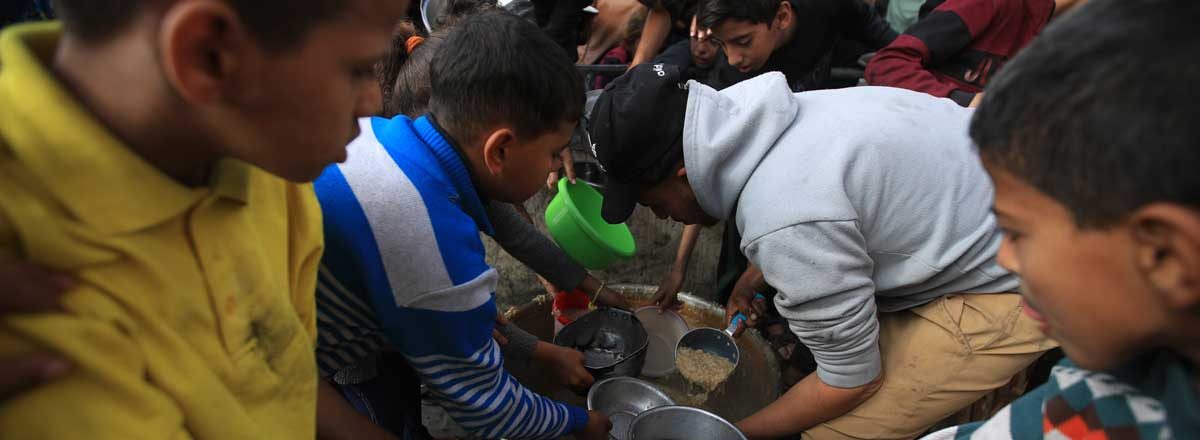Everyone in Gaza is going hungry. About 2.2 million people are surviving day by day on almost nothing, routinely going without meals. The desperate search for food is relentless, and usually unsuccessful, leaving the entire population – including babies, children, pregnant or nursing women and the elderly – hungry.

The Gaza Strip was already in the throes of a humanitarian crisis before the war, mainly due to Israel’s 17-year blockade. About 80% of the population relied on humanitarian aid. Some 44% of households were food insecure and another 16% were at risk of food insecurity. Given this starting point, it is clear why Gaza plummeted into a full-blown catastrophe so quickly.
On 21 December 2023, the Integrated Food Security Phase Classification (IPC) Famine Review Committee (FRC) published a report on the situation in Gaza. The FRC, which consists of independent experts, uses the internationally accepted classification of food insecurity levels, the most severe being Phase 5 – Catastrophe/Famine. According to this method, urgent intervention is needed as of Phase 3 (Crisis or worse) in order to protect the population.
The FRC report is based on information collected in the Gaza Strip from 24 November 2023 to 7 December 2023. The committee found that during this time, in four of five households in northern Gaza and in half of IDP households in the south, residents went days without any food and many skipped meals to feed their children. About 93% of the population in Gaza – some 2.08 million people – were suffering from acute food insecurity at Phase 3 or higher, with over 15% – 378,000 people – already at Phase 5.
The report also forecasts that by 7 February 2024, the entire population of the Gaza Strip will reach Phase 3 or worse. At least one in four residents – more than 500,000 people – is expected to be at Phase 5, facing extreme food shortages, hunger and exhaustion. According to the report, if current conditions persist, there is a significant risk that famine will be declared throughout the entire Gaza Strip within six months. Such a declaration is made when 20% of households reach Phase 5, when 30% of children suffer from severe malnutrition, and when two adults or four children out of 10,000 die of hunger every day.
Similarly, a UNICEF survey from 26 December 2023 found that an increasing number of children are not receiving their basic nutritional needs. About 90% of children under age two in Gaza consume food from two or fewer food groups. In a survey conducted two weeks earlier, the figure was 80%. The nutrition of pregnant and nursing women has also been severely compromised, with 25% consuming only one type of food, and almost 65% only two types.
This reality is not a byproduct of war, but a direct result of Israel’s declared policy. Residents now depend entirely on food supplies from outside Gaza, as they can no longer produce almost any food themselves. Most cultivated fields have been destroyed, and accessing open areas during the war is dangerous in any case. Bakeries, factories and food warehouses have been bombed or shut down due to lack of basic supplies, fuel and electricity. Stockpiles in private homes, stores and warehouses have long since run out. In these conditions, the family and social support networks that helped residents at the beginning of the war collapsed, too.
Yet Israel is deliberately denying the entry of enough food into Gaza to meet the population’s needs. Only a fraction of the amount of food entering before the war is allowed in, with limitations on the types of goods, how they are brought in and how they are distributed within Gaza.
For example, almost all goods enter through Rafah Crossing, a passenger crossing that is not equipped for massive commercial transports, limiting the number of truckloads getting through and creating a bottleneck. Although Israel recently allowed trucks in through Kerem Shalom Crossing, too, which is designed for commercial transports, this was merely a token addition that has failed to alleviate the hardship. Additionally, Israel forces aid organizations to purchase food from Egypt and prevents them from buying it in Israel, which would allow for a more efficient and rapid transfer of goods. Israel also prohibits the private sector in Gaza from purchasing food, which could significantly increase supply.
Aid organizations are struggling to operate under current conditions, and most of the limited aid allowed in remains in Rafah instead of reaching residents throughout the Strip. Martin Griffiths, the UN Under-Secretary-General for Humanitarian Affairs and Emergency Relief Coordinator, listed several reasons why aid cannot be efficiently distributed. Among other things, he noted that trucks are inspected several times before Israel allows them into Gaza, and even then, long lines form due to the conditions at Rafah Crossing. The little food that does get in is very difficult to distribute due to the constant bombings, destroyed roads, frequent communication blackouts, and shelters overflowing with of hundreds of thousands of IDPs crowding into smaller and smaller areas.
Israel can, if it so chooses, change this reality. The images of children begging for food, people waiting in long lines for paltry handouts and hungry residents charging at aid trucks are already inconceivable. The horror is growing by the minute, and the danger of famine is real. Still, Israel persists in its policy.
Changing this policy is not just a moral obligation. Allowing food into the Gaza Strip is not an act of kindness but a positive obligation under international humanitarian law: starvation as a method of warfare is prohibited, and when a civilian population lacks what it needs to survive, parties to the conflict have a positive obligation to allow rapid and unimpeded passage of humanitarian aid – including food. These two rules are considered customary law and violating them constitutes a war crime under the Rome Statute of the International Criminal Court.
